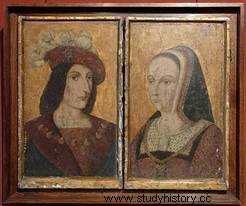 The Renaissance in France is often reduced to the reign of King François I, a sort of prosperous period before the horror of the Wars of Religion. However, it is more accurate to begin this period with Charles VIII, the first king of the Renaissance, and to conclude it with Henry II. For political reasons (the situation in France, the evolution of the monarchy), and in other areas, such as that of the arts or the relationship with Italy, whose Renaissance began a while ago. We will see that the reigns of Charles VIII, Louis XII, François Ier and Henri II are much more than a transition and a parenthesis between the end of the Hundred Years War and the beginning of the Wars of Religion.
The Renaissance in France is often reduced to the reign of King François I, a sort of prosperous period before the horror of the Wars of Religion. However, it is more accurate to begin this period with Charles VIII, the first king of the Renaissance, and to conclude it with Henry II. For political reasons (the situation in France, the evolution of the monarchy), and in other areas, such as that of the arts or the relationship with Italy, whose Renaissance began a while ago. We will see that the reigns of Charles VIII, Louis XII, François Ier and Henri II are much more than a transition and a parenthesis between the end of the Hundred Years War and the beginning of the Wars of Religion.
Charles VIII (1483-1498), first king of the Renaissance
The harsh and disputed reign of Louis XI (1461-1483), considered by some to be a tyrant, was followed by that of his son Charles VIII. The young king was however still a minor on his accession, and the regency was organized by his father, who entrusted it to his daughter Anne of France and her husband, Pierre de Beaujeu (from the house of Bourbon-Beaujeu). This is not without provoking disputes, such as that of Louis d'Orléans. Dismissed by the Estates General in Tours in 1484, the latter revolted with the support of the Duke of Brittany:this was the start of the "mad war" in 1485. The rebels were defeated in July 1488, at Saint-Aubin- du-Cormier, and Louis d'Orléans was taken prisoner. King Charles VIII accomplishes one of his first great deeds by pardoning his enemy, who later becomes a valuable ally, and more. At the same time, Charles VIII affirms his authority over the Beaujeu:it is the end of the regency. The king completes the settlement of the problem of Brittany by marrying Anne, duchess since 1489, thus opposing head-on the ambitions of Maximilien de Habsbourg; however, he had to cede Franche-Comté and Artois to him. 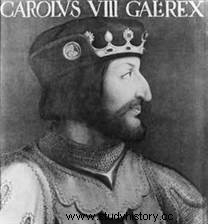 Charles VIII then turns to Italy claiming the kingdom of Naples, former possession of the house of Anjou. It is in fact only a step to launch a new crusade for Jerusalem. Ready to do anything to achieve his goal, the king ensured the neutrality of his powerful neighbors by ceding territories to them, such as Roussillon and Cerdanya in favor of Ferdinand of Aragon.
Charles VIII then turns to Italy claiming the kingdom of Naples, former possession of the house of Anjou. It is in fact only a step to launch a new crusade for Jerusalem. Ready to do anything to achieve his goal, the king ensured the neutrality of his powerful neighbors by ceding territories to them, such as Roussillon and Cerdanya in favor of Ferdinand of Aragon.
In Italy, he allies himself with the Duke of Milan Ludovico Sforza. Despite his entry into Rome imposed on Pope Alexander VI Borgia, then his capture of Naples without difficulty in 1495, the Italian campaign was a bitter failure for Charles VIII, who had to leave the peninsula hastily after an unexpected victory at Fornoue. The king plans to try the experiment again, but he dies accidentally in Amboise on April 7, 1498.
Charles VIII governed with the various courts set up by his predecessors, without major conflict, even if at the same time he extended his power to nominate offices. He also attempted some tax reforms, without much success, and encouraged trade by restoring the fairs of Lyon. In the field of the arts, he contributed to the arrival in France of Italian artists and technicians, and he protected someone like Jean Bourdichon.
Louis XII (1498-1515), the “Father of the People”
Charles VIII died at the age of twenty-seven without an heir, the dauphin Charles-Orland having died prematurely in 1495. In compliance with Salic law, it was the king's cousin, Louis of Orléans, his former enemy of the "war crazy”, which succeeds him and this without really contesting. Thus ended the direct Valois dynasty. Having become Louis XII, the Duke of Orléans must very quickly manage a new Breton problem. Indeed, Anne, being the widow of Charles VIII, can recover her duchy and retain the relative independence of Brittany. A skilful negotiator, Louis XII obtained from Pope Alexander VI Borgia the annulment of his previous marriage with Joan of France; he could thus in turn marry Anne of Brittany in January 1499. At the end of this year, they had a daughter, Claude, who was to inherit her mother's duchy. She tries to negotiate the marriage of her daughter with Charles de Gand (future Charles Quint), with an agreement which would cede to Claude not only Brittany, but also Burgundy, the heritage of the Dukes of Orleans and the rights to Italy! This is too much, the unity of the kingdom is threatened and, under many pressures, Louis XII regains control:against his wife's advice, he betroths Claude to François d'Angoulême (future François I) in 1506. He still waited for Anne's death to marry the couple in 1514. 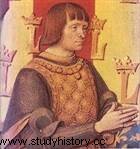 Apart from Brittany, Louis XII's main objective, like his predecessor, was Italy. He asserts his rights over the Milanese, because he is the grandson of Valentine Visconti, the family of the latter having been excluded from the duchy by the Sforzas. The conquest took place in two stages, in 1499 then in 1500:Ludovic Sforza, known as the More, was taken prisoner (he died in captivity eight years later). Louis XII then decides to recover the kingdom of Naples, and for this he allies himself with Ferdinand of Aragon by the treaty of Granada in 1500. The failure is however the same as that of Charles VIII after the falling out with the king of 'Aragon. In 1504, the Kingdom of Naples was definitively lost.
Apart from Brittany, Louis XII's main objective, like his predecessor, was Italy. He asserts his rights over the Milanese, because he is the grandson of Valentine Visconti, the family of the latter having been excluded from the duchy by the Sforzas. The conquest took place in two stages, in 1499 then in 1500:Ludovic Sforza, known as the More, was taken prisoner (he died in captivity eight years later). Louis XII then decides to recover the kingdom of Naples, and for this he allies himself with Ferdinand of Aragon by the treaty of Granada in 1500. The failure is however the same as that of Charles VIII after the falling out with the king of 'Aragon. In 1504, the Kingdom of Naples was definitively lost.
The King of France did not abandon his ambitions in Italy, however, and played with all his weight in the peninsula:he crushed a revolt in Genoa in 1507, then s allies with Pope Julius II and the other great powers (except England) within the league of Cambrai, to defeat Venice in 1509.
From that moment, France was in such a position of strength in Italy that it could not last:Julius II understood this and formed a Holy League against Louis XII. All the Italian possessions were lost one by one, and the kingdom was even directly threatened when Henry VIII took Tournai in 1513. Louis XII had to comply with the demands of his conquerors and put an end to his ambitions in Italy. Widowed in 1514, he remarried Henry VIII's daughter, Marie Tudor. But she did not have time to give him an heir when he died in 1515.
Little known today among the kings of France, Louis XII was nevertheless a popular king, long celebrated thereafter, and even shown as a model during the wars of religion . He received the title of "People's Father" in 1506 at the Assembly of Tours. Despite this, after a drop in size, the king increased taxation to pay for his wars in Italy. He nevertheless wanted to fight against abuses in the collection of taxes, and France experienced a certain period of prosperity under his reign. With the help of Georges d'Amboise, Louis XII continued to reform the institutions through a series of ordinances on justice or the drafting of customs. Quite religious, the king still opposed Pope Julius II, against whom he called a council in Pisa in 1511, without success.
Francis I (1515-1547), "king knight and restorer of letters"
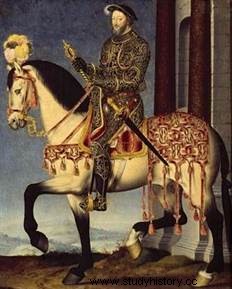 Once again, the succession is uncontested. François I was crowned on January 25, 1515, and reorganized the king's close council, for example by appointing Charles de Bourbon as the new constable. He in turn claims the Milanese, which he recovers thanks to the victory of Marignan in September 1515. This does not prevent him from approaching the Medici Pope, Leo X, against the advice of the parliament and the University of Paris. If Europe is at peace, the rivalry comes quickly with the advent of Charles V, who is elected emperor to the detriment of François Ier. The latter then approaches Henry VIII, during the famous interview at the Camp du Drap d’Or (1520). War is nevertheless inevitable, and François I quickly finds himself lonely:Henry VIII supports Charles V, and the constable Charles de Bourbon betrays him! The King of France then tried to regain the initiative on the ground which had brought him luck until then:Italy. Unfortunately, he was beaten at Pavia in 1525, and above all taken prisoner! Charles V only agrees to release him if he restores Burgundy to him (the emperor is the great-grandson of Charles the Bold); Francis I accepts the Treaty of Madrid, but does not respect his word on his release. As the war resumed, he obtained the support of Pope Clement VII, which led the emperor to loot Rome in 1527. Two years later, the "Peace of the Ladies" put an end to the conflict for a time.
Once again, the succession is uncontested. François I was crowned on January 25, 1515, and reorganized the king's close council, for example by appointing Charles de Bourbon as the new constable. He in turn claims the Milanese, which he recovers thanks to the victory of Marignan in September 1515. This does not prevent him from approaching the Medici Pope, Leo X, against the advice of the parliament and the University of Paris. If Europe is at peace, the rivalry comes quickly with the advent of Charles V, who is elected emperor to the detriment of François Ier. The latter then approaches Henry VIII, during the famous interview at the Camp du Drap d’Or (1520). War is nevertheless inevitable, and François I quickly finds himself lonely:Henry VIII supports Charles V, and the constable Charles de Bourbon betrays him! The King of France then tried to regain the initiative on the ground which had brought him luck until then:Italy. Unfortunately, he was beaten at Pavia in 1525, and above all taken prisoner! Charles V only agrees to release him if he restores Burgundy to him (the emperor is the great-grandson of Charles the Bold); Francis I accepts the Treaty of Madrid, but does not respect his word on his release. As the war resumed, he obtained the support of Pope Clement VII, which led the emperor to loot Rome in 1527. Two years later, the "Peace of the Ladies" put an end to the conflict for a time. 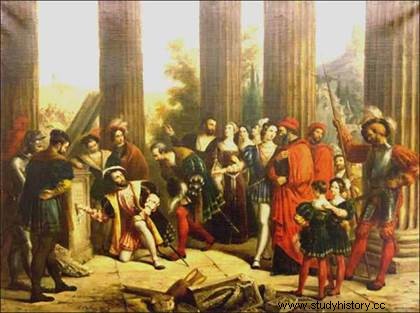 The reign of Francis I entered a new phase, and he surrounded himself with new advisers like Anne de Montmorency . The king regains control in most areas, including religion, to the point of trying to mediate between Henry VIII and the pope. The Protestant “problem” is, however, increasingly persistent. At the end of the 1530s, the war resumed with Charles V and then Henry VIII, once again with the Milanese and Burgundy as the stakes. François I hesitated for a long time on the policy to follow, but the aggravation of the conflict led to the disgrace of Anne de Montmorency, in favor of an agreement with the Emperor. The Peace of Crépy was signed with the latter in 1544, then two years later the Treaty of Ardres allowed the end of the war with England. Francis I died weakened March 31, 1547, the country in difficulty in many areas, including financial.
The reign of Francis I entered a new phase, and he surrounded himself with new advisers like Anne de Montmorency . The king regains control in most areas, including religion, to the point of trying to mediate between Henry VIII and the pope. The Protestant “problem” is, however, increasingly persistent. At the end of the 1530s, the war resumed with Charles V and then Henry VIII, once again with the Milanese and Burgundy as the stakes. François I hesitated for a long time on the policy to follow, but the aggravation of the conflict led to the disgrace of Anne de Montmorency, in favor of an agreement with the Emperor. The Peace of Crépy was signed with the latter in 1544, then two years later the Treaty of Ardres allowed the end of the war with England. Francis I died weakened March 31, 1547, the country in difficulty in many areas, including financial. Known for his major architectural projects and his patronage, François I also strengthened royal power and led decisive reforms, such as the ordinance of Villers-Cotterêts (1539). In the context of the Reformation, it went from relative tolerance towards Protestants to fierce repression, of which the humanist Etienne Dolet, among others, fell victim.
Henry II (1547-1559), the “gentleman king”
Second son of Francis I, Henry II opposed his father at an early age. It is therefore no coincidence that he recalled to court the disgraced such as Anne de Montmorency upon her accession to the throne. The new king must first settle the tax disputes bequeathed by his father, which broke out under the name of "revolt of the gabelle", before Montmorency put it down at the end of the year 1548.
Henri II has no intention of abandoning France's foreign claims. He had challenged the Treaty of Ardres, and therefore entered the war again with England, supporting the Scots, then managing to recover Boulogne. The king also opposed his father's great rival, Charles V, who was unable to bring him down by failing before Metz in 1553. Henry II took advantage of this to try to regain a foothold in northern Italy but, despite the withdrawal of Charles V, the difficulties accumulate:France finds itself with against it the Spain of Philip II and the England of Mary Tudor.
The country is directly threatened with the siege of Saint-Quentin (Anne de Montmorency is captured), which leads to the recall of the Duke of Guise from Italy. This one had spectacular successes, such as the recovery of Calais in 1558, and became very popular. This was not enough to compensate for the many internal problems, and Henry II had to sign the Treaty of Cateau-Cambrésis in April 1559, definitively abandoning French ambitions in Italy. The king died on July 10, 1559, following an injury during the engagement tournament of one of his daughters.
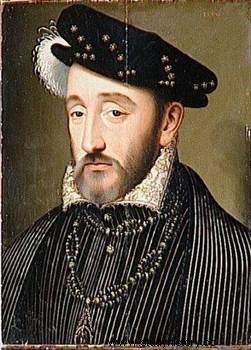 Following the policy of his father, and with the help of his wife Catherine de Medici, Henri It reinforces the artistic and cultural aura of a France emancipated from Italian influence; it is the time of Rabelais, Ronsard, François Clouet or Pierre Lescot. Initiator of many institutional reforms, he could not however solve the many economic and financial problems of the kingdom, which continued to worsen during his reign. In addition, the religious context became tense and the repression against Protestants intensified...
Following the policy of his father, and with the help of his wife Catherine de Medici, Henri It reinforces the artistic and cultural aura of a France emancipated from Italian influence; it is the time of Rabelais, Ronsard, François Clouet or Pierre Lescot. Initiator of many institutional reforms, he could not however solve the many economic and financial problems of the kingdom, which continued to worsen during his reign. In addition, the religious context became tense and the repression against Protestants intensified... Henry II's succession fell to his young son François II, who did not reign just over a year. The Guise see their influence increase, and France enters the long and painful period of the Wars of Religion. The Renaissance, with these four major kings, was therefore not only a time of cultural and artistic brilliance for France, but also that of reforms and political, economic and religious upheavals that were decisive for the future.
Bibliography
- P. Hamon, The Renaissances (1453-1559), Belin, 2009.
- A. Jouanna, P. Hamon, D. Biloghi, G. Le Thiec, La France de la Renaissance. History and Dictionary, Robert Laffont, 2001.
- A. Jouanna, La France au XVIe siècle (1483-1598), PUF, 2006.
- France 1500. Between the Middle Ages and the Renaissance, Exhibition catalogue, RMN, 2010.
